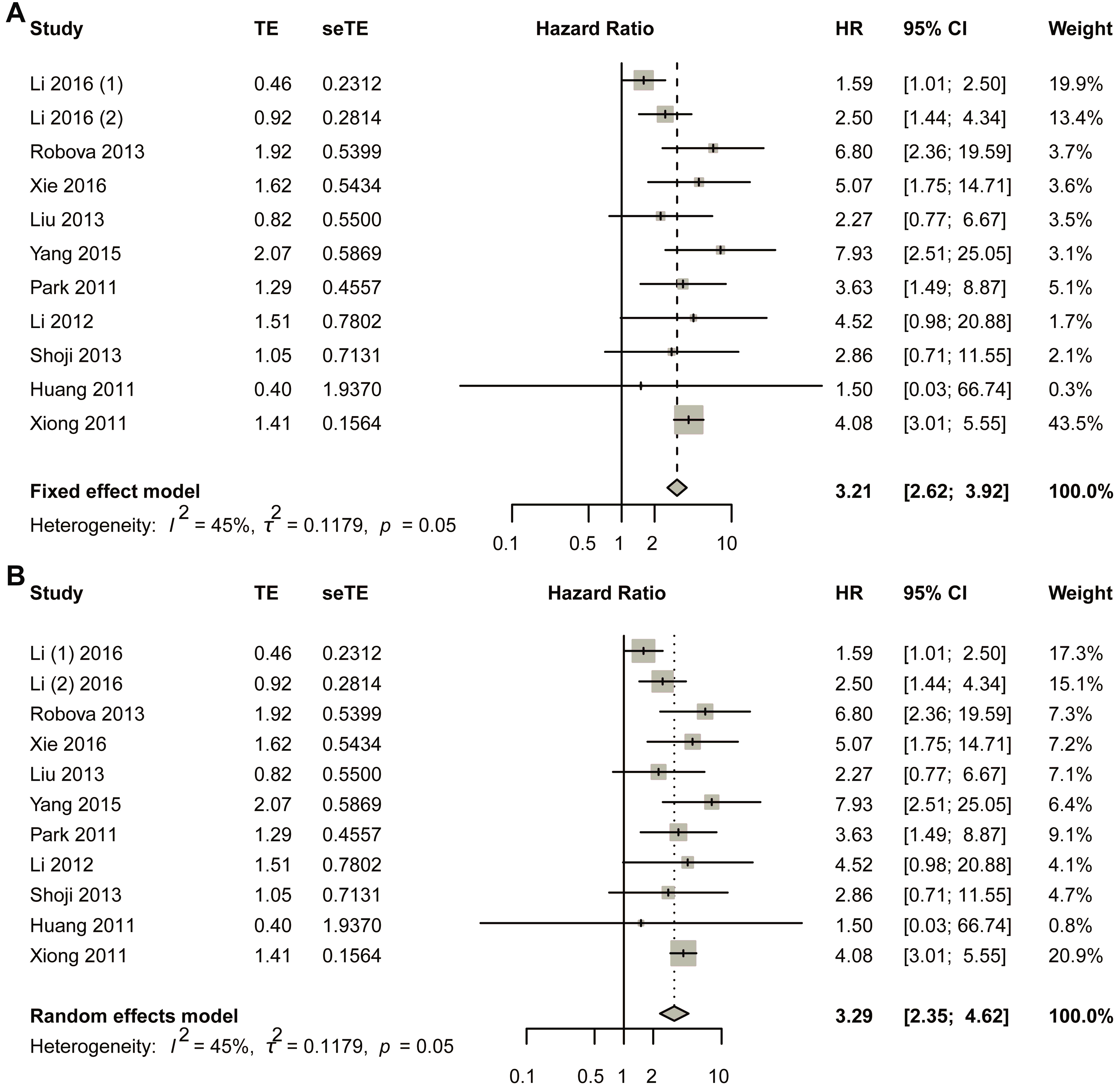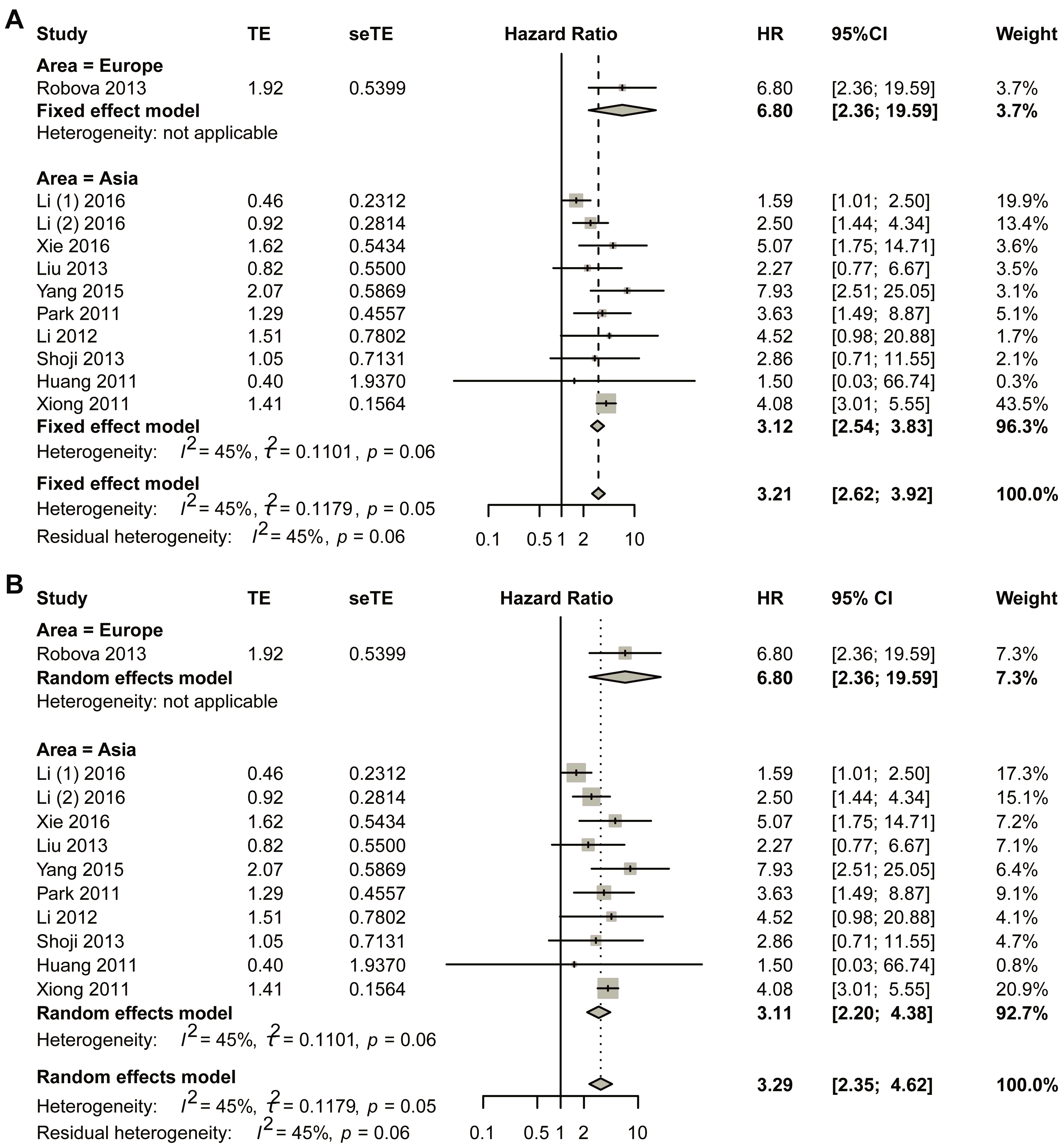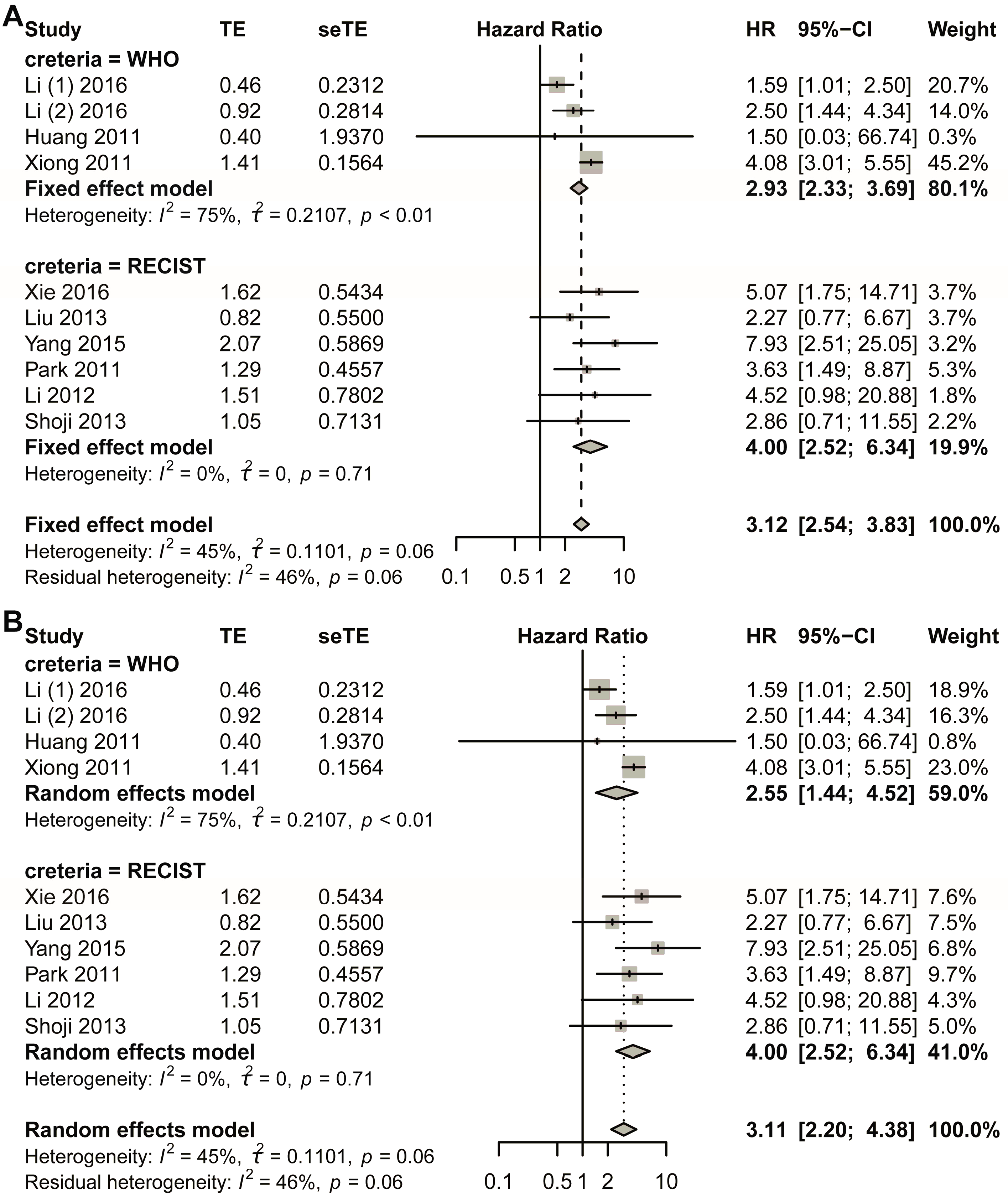Early Non-Response to Neoadjuvant Chemotherapy Will Increase the Recurrence of Cervical Cancer: A Systematic Review
Abstract
1. Introduction
2. Materials and Methods
3. Results
3.1. Features of Qualified Studies Related to HRs
3.2. Combination Result for Included Studies
3.3. Sub-Group Analysis Based on Response Criterion
3.4. Sub-Group Analysis Based on Different Areas
3.5. Sub-Group Analysis for Asian Studies
4. Discussion
5. Conclusions
Supplementary Materials
Author Contributions
Funding
Institutional Review Board Statement
Informed Consent Statement
Data Availability Statement
Acknowledgments
Conflicts of Interest
Abbreviations
| LACC | Locally advanced cervical cancer |
| NACT | Neoadjuvant chemotherapy |
| DFS | Disease-free survival |
| RFS | Recurrence-free survival |
| HR | Hazard ratio |
| CI | Confidence interval |
| RECIST | Response evaluation criteria in solid tumors |
| ALDH1 | Aldehyde dehydrogenas 1 |
| ERCC1 | Excision repair cross-complementation gene group 1 |
| LVSI | Lymph-vascular space invasion |
References
- Siegel, R.L.; Kratzer, T.B.; Giaquinto, A.N.; Sung, H.; Jemal, A. Cancer statistics, 2025. CA Cancer J. Clin. 2025, 75, 10–45. [Google Scholar] [CrossRef]
- Salman, L.; Covens, A. Fertility Preservation in Cervical Cancer-Treatment Strategies and Indications. Curr. Oncol. 2024, 31, 296–306. [Google Scholar] [CrossRef]
- NCCN. Clinical Practice Guidelines in Oncology (NCCN Guidelines®) Cervical Cancer 2025, Version 4; NCCN: Plymouth, PA, USA, 2025. [Google Scholar]
- Bentivegna, E.; Gouy, S.; Maulard, A.; Chargari, C.; Leary, A.; Morice, P. Oncological outcomes after fertility-sparing surgery for cervical cancer: A systematic review. Lancet Oncol. 2016, 17, e240–e253. [Google Scholar] [CrossRef] [PubMed]
- Rob, L.; Skapa, P.; Robova, H. Fertility-sparing surgery in patients with cervical cancer. Lancet Oncol. 2011, 12, 192–200. [Google Scholar] [CrossRef] [PubMed]
- Dzyubak, O.; Glass, K.; Watts, M.; Tarafdar, O.; Simpson, A.N.; Maganti, M.; Deljoomanesh, S.; Laframboise, S.; Bernardini, M.Q.; Pakbaz, S.; et al. Oncologic and fertility outcomes of progestin therapy for atypical hyperplasia and grade 1 cancer of the endometrium: Results of a specialized oncofertility program. Gynecol. Oncol. 2025, 199, 72–78. [Google Scholar] [CrossRef]
- Chatziioannou, S.S.; Papasideri, V.; Sofoudis, C. Fertility-sparing surgery upon reproductive and oncologic results in ovarian cancer patients stage I (FIGO): A systematic review. Arch. Gynecol. Obstet. 2025, 17, 141–145. [Google Scholar] [CrossRef]
- Joshi, R.M.; Telang, B.; Soni, G.; Khalife, A. Overview of perspectives on cancer, newer therapies, and future directions. Oncol. Transl. Med. 2024, 10, 105–109. [Google Scholar]
- Perrone, M.G.; Vitale, P.; Miciaccia, M.; Ferorelli, S.; Centonze, A.; Solidoro, R.; Munzone, C.; Bonaccorso, C.; Fortuna, C.G.; Kleinmanns, K.; et al. Fluorochrome Selection for Imaging Intraoperative Ovarian Cancer Probes. Pharmaceuticals 2022, 15, 668. [Google Scholar] [CrossRef]
- Maiorano, M.F.P.; Maiorano, B.A.; Cormio, G.; Loizzi, V. Mucinous Ovarian Carcinoma: Integrating Molecular Stratification into Surgical and Therapeutic Management. Biomedicines 2025, 13, 1198. [Google Scholar] [CrossRef]
- Stroup, D.F.; Berlin, J.A.; Morton, S.C.; Olkin, I.; Williamson, G.D.; Rennie, D.; Moher, D.; Becker, B.J.; Sipe, T.A.; Thacker, S.B. Meta-analysis of observational studies in epidemiology: A proposal for reporting. Meta-analysis Of Observational Studies in Epidemiology (MOOSE) group. JAMA 2000, 283, 2008–2012. [Google Scholar] [CrossRef]
- Page, M.J.; McKenzie, J.E.; Bossuyt, P.M.; Boutron, I.; Hoffmann, T.C.; Mulrow, C.D.; Shamseer, L.; Tetzlaff, J.M.; Akl, E.A.; Brennan, S.E.; et al. The PRISMA 2020 statement: An updated guideline for reporting systematic reviews. BMJ 2021, 372, n71. [Google Scholar] [CrossRef] [PubMed]
- Williamson, P.R.; Smith, C.T.; Hutton, J.L.; Marson, A.G. Aggregate data meta-analysis with time-to-event outcomes. Stat. Med. 2002, 21, 3337–3351. [Google Scholar] [CrossRef] [PubMed]
- Tierney, J.F.; Stewart, L.A.; Ghersi, D.; Burdett, S.; Sydes, M.R. Practical methods for incorporating summary time-to-event data into meta-analysis. Trials 2007, 8, 16. [Google Scholar] [CrossRef] [PubMed]
- Stang, A. Critical evaluation of the Newcastle-Ottawa scale for the assessment of the quality of nonrandomized studies in meta-analyses. Eur. J. Epidemiol. 2010, 25, 603–605. [Google Scholar] [CrossRef] [PubMed]
- Litiere, S.; Collette, S.; de Vries, E.G.; Seymour, L.; Bogaerts, J. RECIST—Learning from the past to build the future. Nat. Rev. Clin. Oncol. 2017, 14, 187–192. [Google Scholar] [CrossRef]
- Higgins, J.P.; Thompson, S.G.; Deeks, J.J.; Altman, D.G. Measuring inconsistency in meta-analyses. BMJ 2003, 327, 557–560. [Google Scholar] [CrossRef]
- Higgins, J.P.; Thompson, S.G. Quantifying heterogeneity in a meta-analysis. Stat. Med. 2002, 21, 1539–1558. [Google Scholar] [CrossRef]
- DerSimonian, R.; Laird, N. Meta-analysis in clinical trials. Control. Clin. Trials 1986, 7, 177–188. [Google Scholar] [CrossRef]
- Patsopoulos, N.A.; Evangelou, E.; Ioannidis, J.P. Sensitivity of between-study heterogeneity in meta-analysis: Proposed metrics and empirical evaluation. Int. J. Epidemiol. 2008, 37, 1148–1157. [Google Scholar] [CrossRef]
- Begg, C.B.; Mazumdar, M. Operating characteristics of a rank correlation test for publication bias. Biometrics 1994, 50, 1088–1101. [Google Scholar] [CrossRef]
- Egger, M.; Davey Smith, G.; Schneider, M.; Minder, C. Bias in meta-analysis detected by a simple, graphical test. BMJ 1997, 315, 629–634. [Google Scholar] [CrossRef]
- Huang, X.; Lan, C.; Huang, H.; Zhang, Y.; Cao, X.; Huang, Y.; Guo, Y.; Wan, T.; Liu, J. Neoadjuvant docetaxel combined with cisplatin and followed by radical surgery for the treatment of locally advanced (stage IB2-IIB) cervical cancer: Preliminary results of a single-institution experience. Expert Opin. Pharmacother. 2011, 12, 165–173. [Google Scholar] [CrossRef]
- Li, R.; Lu, S.T.; Si, J.G.; Liu, B.; Wang, H.; Mei, Y.Y.; Linghu, H. Prognostic value of responsiveness of neoadjuvant chemotherapy before surgery for patients with stage IB(2)/IIA(2) cervical cancer. Gynecol. Oncol. 2013, 128, 524–529. [Google Scholar] [CrossRef]
- Li, X.; Huang, K.; Zhang, Q.; Shen, J.; Zhou, H.; Yang, R.; Wang, L.; Liu, J.; Zhang, J.; Sun, H.; et al. Early response to neoadjuvant chemotherapy can help predict long-term survival in patients with cervical cancer. Oncotarget 2016, 7, 87485–87495. [Google Scholar] [CrossRef]
- Liu, S.P.; Yang, J.X.; Cao, D.Y.; Shen, K.; Xiang, Y.; Lang, J.H. Efficacy of neoadjuvant cisplatin and 5-flourouracil prior to surgery in FIGO stage IB2/IIA2 cervical cancer. Mol. Clin. Oncol. 2014, 2, 240–244. [Google Scholar] [CrossRef]
- Park, J.S.; Jeon, E.K.; Chun, S.H.; Won, H.S.; Lee, A.; Hur, S.Y.; Lee, K.H.; Bae, S.N.; Yoon, S.C.; Hong, S.H. ERCC1 (excision repair cross-complementation group 1) expression as a predictor for response of neoadjuvant chemotherapy for FIGO stage 2B uterine cervix cancer. Gynecol. Oncol. 2011, 120, 275–279. [Google Scholar] [CrossRef]
- Robova, H.; Rob, L.; Halaska, M.J.; Pluta, M.; Skapa, P.; Strnad, P.; Lisy, J.; Komar, M. High-dose density neoadjuvant chemotherapy in bulky IB cervical cancer. Gynecol. Oncol. 2013, 128, 49–53. [Google Scholar] [CrossRef] [PubMed]
- Shoji, T.; Takatori, E.; Saito, T.; Omi, H.; Kagabu, M.; Miura, F.; Takeuchi, S.; Sugiyama, T. Neoadjuvant chemotherapy using platinum- and taxane-based regimens for bulky stage Ib2 to IIb non-squamous cell carcinoma of the uterine cervix. Cancer Chemother. Pharmacol. 2013, 71, 657–662. [Google Scholar] [CrossRef] [PubMed]
- Xie, Q.; Liang, J.; Rao, Q.; Xie, X.; Li, R.; Liu, Y.; Zhou, H.; Han, J.; Yao, T.; Lin, Z. Aldehyde Dehydrogenase 1 Expression Predicts Chemoresistance and Poor Clinical Outcomes in Patients with Locally Advanced Cervical Cancer Treated with Neoadjuvant Chemotherapy Prior to Radical Hysterectomy. Ann. Surg. Oncol. 2016, 23, 163–170. [Google Scholar] [CrossRef]
- Xiong, Y.; Liang, L.Z.; Cao, L.P.; Min, Z.; Liu, J.H. Clinical effects of irinotecan hydrochloride in combination with cisplatin as neoadjuvant chemotherapy in locally advanced cervical cancer. Gynecol. Oncol. 2011, 123, 99–104. [Google Scholar] [CrossRef] [PubMed]
- Yang, L.; Guo, J.; Shen, Y.; Cai, J.; Xiong, Z.; Dong, W.; Min, J.; Wang, Z. Clinical efficacy and safety of paclitaxel plus carboplatin as neoadjuvant chemotherapy prior to radical hysterectomy and pelvic lymphadenectomy for Stage IB2-IIB cervical cancer. Int. J. Clin. Exp. Med. 2015, 8, 13690–13698. [Google Scholar]
- Siegel, R.L.; Giaquinto, A.N.; Jemal, A. Cancer statistics, 2024. CA Cancer J. Clin. 2024, 74, 12–49. [Google Scholar] [CrossRef]
- Bray, F.; Laversanne, M.; Sung, H.; Ferlay, J.; Siegel, R.L.; Soerjomataram, I.; Jemal, A. Global cancer statistics 2022: GLOBOCAN estimates of incidence and mortality worldwide for 36 cancers in 185 countries. CA Cancer J. Clin. 2024, 74, 229–263. [Google Scholar] [CrossRef]
- Hu, T.; Li, S.; Chen, Y.; Shen, J.; Li, X.; Huang, K.; Yang, R.; Wu, L.; Chen, Z.; Jia, Y.; et al. Matched-case comparison of neoadjuvant chemotherapy in patients with FIGO stage IB1-IIB cervical cancer to establish selection criteria. Eur. J. Cancer 2012, 48, 2353–2360. [Google Scholar] [CrossRef]
- Winata, I.G.S.; Budiana, I.N.G.; Jawi, I.M.; Suwiyoga, K. Neoadjuvant chemotherapy in stadium IB3, IIA2 and IIB cervical cancer a narrative review. Biomed. Pharmacol. J. 2022, 15, 901–910. [Google Scholar] [CrossRef]
- Mori, T.; Hosokawa, K.; Sawada, M.; Kuroboshi, H.; Tatsumi, H.; Koshiba, H.; Okubo, T.; Kitawaki, J. Neoadjuvant weekly carboplatin and paclitaxel followed by radical hysterectomy for locally advanced cervical cancer: Long-term results. Int. J. Gynecol. Cancer 2010, 20, 611–616. [Google Scholar] [CrossRef]
- MacLeod, C.; O'Donnell, A.; Tattersall, M.H.; Dalrymple, C.; Firth, I. Locally advanced cervix cancer: Chemotherapy prior to definitive surgery or radiotherapy. A single institutional experience. Australas Radiol. 2001, 45, 491–495. [Google Scholar] [CrossRef] [PubMed]
- Selvaggi, L.; Loizzi, V.; AR, D.I.G.; Nardelli, C.; Cantatore, C.; Cormio, G. Neoadjuvant chemotherapy in cervical cancer: A 67 patients experience. Int. J. Gynecol. Cancer 2006, 16, 631–637. [Google Scholar] [CrossRef]
- Ma, L.; Hua, R.X.; Lin, H.; Zhu, J.; Fu, W.; Lin, A.; Zhang, J.; Cheng, J.; Zhou, H.; Li, S.; et al. The contribution of WTAP gene variants to Wilms tumor susceptibility. Gene 2020, 754, 144839. [Google Scholar] [CrossRef] [PubMed]
- Zhang, Y.; Xia, Z.G.; Zhu, J.H.; Chen, M.B.; Wang, T.M.; Shen, W.X.; He, J. Association of Interleukin-10 -3575T>A and -1082A>G polymorphisms with non-Hodgkin lymphoma susceptibility: A comprehensive review and meta-analysis. Mol. Genet. Genomics 2015, 290, 2063–2073. [Google Scholar] [CrossRef]





| Study | Publishing Time | Location | Study Period | Population | Data Type | No. of Cases (Non-RESPONDERS) | No. of All Patients | Age at Baseline, y | Chemotherapy Cycles | FIGO Stage | Response Evaluation Guidelines | Using K-M for Data Extraction or Not | Effect Size from Cox Model or Not | Adjustment | Follow-Up Period |
|---|---|---|---|---|---|---|---|---|---|---|---|---|---|---|---|
| Robova [28] | 2013 | Czech Republic | 1998–2009 | Czech | Prospective | 32 | 151 | Mean age was 45.7 (range 20 to 70 years) | 3–4 | IB1-IB2 | WHO Criteria | Yes | No | None | 29–154 months |
| Liu [26] | 2013 | China | 2002–2011 | Chinese | Retrospective | 40 | 103 | Unknown | 2–3 | IB2/IIA2 | RECIST Criteria | Yes | No | None | 6–113 months |
| Huang [23] | 2011 | China | 2007–2009 | Chinese | Retrospective | 7 | 52 | Median (Range),46 (30 to 63) | 2–3 | IB2-IIA | WHO Criteria | Yes | No | None | 7.1–29.3 months |
| Xie [30] | 2016 | China | 2003–2008 | Chinese | Retrospective | 18 | 52 | Median (Range), 43 (27 to 63) | 2–3 | IB2-IIB | RECIST Criteria | No | Yes | Tumor size, the expression of ALDH1 | 3–123 months |
| Yang [32] | 2015 | China | 2007–2012 | Chinese | Retrospective | 33 | 115 | Median (Range), 45 (23 to 68) | unknown | IB2-IIB | RECIST Criteria | Yes | No | None | 6–75 months |
| Park [27] | 2011 | Korean | 1997–2007 | Chinese | Prospective | 15 | 43 | Median (Range), 50 (30 to 78) | Mostly 3 | IIB | RECIST Criteria | No | Yes | Node, the expression of ERCC1 | 6–139 months |
| Li [24] | 2012 | China | 2000–2011 | Chinese | Retrospective | 43 | 154 | Mean ± SD, 41.6 ± 7.92 | 2–3 | IB2/IIA2 | RECIST Criteria | Yes | No | None | 6–142 months |
| Shoji [29] | 2013 | Japan | 2002–2011 | Japanese | Pilot study | 5 | 23 | Median (Range), 50 (32 to 63) | 1–3 | IB2-IIB | RECIST Criteria | No | Yes | None | 9–90 months |
| Li (1) [25] | 2016 | China | 1999–2008 | Chinese | Retrospective | 189 | 826 | Median (Range), 44 (39 to 50) | Mostly 1–2 | IB2-IIB | WHO Criteria | No | Yes | Age, Stage, Tumor size, Grade, Cell type, LVSI, Parametrial infiltration, Vaginal surgical margin, Lymph node metastasis | 0–115 months |
| Li (2) [25] | 2016 | China | 2003–2013 | Chinese | Prospective | 115 | 485 | Median (Range), 45 (40 to 49) | Mostly 1–2 | IB2-IIB | WHO Criteria | No | Yes | Age, Stage, Tumor size, Grade, Cell type, LVSI, Parametrial infiltration, Vaginal surgical margin, Lymph node metastasis | 0–100 months |
| Xiong [31] | 2011 | China | 2004–2009 | Chinese | Retrospective | 21 | 60 | Median (Range), 49 (28–61) | 2 | IB2-IIB | WHO criteria | No | No | None | 7–66 months |
Disclaimer/Publisher’s Note: The statements, opinions and data contained in all publications are solely those of the individual author(s) and contributor(s) and not of MDPI and/or the editor(s). MDPI and/or the editor(s) disclaim responsibility for any injury to people or property resulting from any ideas, methods, instructions or products referred to in the content. |
© 2025 by the authors. Licensee MDPI, Basel, Switzerland. This article is an open access article distributed under the terms and conditions of the Creative Commons Attribution (CC BY) license (https://creativecommons.org/licenses/by/4.0/).
Share and Cite
Huang, S.; Yang, R.; Yang, L.; Kong, S.; Huang, K. Early Non-Response to Neoadjuvant Chemotherapy Will Increase the Recurrence of Cervical Cancer: A Systematic Review. Biomedicines 2025, 13, 2016. https://doi.org/10.3390/biomedicines13082016
Huang S, Yang R, Yang L, Kong S, Huang K. Early Non-Response to Neoadjuvant Chemotherapy Will Increase the Recurrence of Cervical Cancer: A Systematic Review. Biomedicines. 2025; 13(8):2016. https://doi.org/10.3390/biomedicines13082016
Chicago/Turabian StyleHuang, Shiqing, Runfeng Yang, Li Yang, Shiyi Kong, and Kecheng Huang. 2025. "Early Non-Response to Neoadjuvant Chemotherapy Will Increase the Recurrence of Cervical Cancer: A Systematic Review" Biomedicines 13, no. 8: 2016. https://doi.org/10.3390/biomedicines13082016
APA StyleHuang, S., Yang, R., Yang, L., Kong, S., & Huang, K. (2025). Early Non-Response to Neoadjuvant Chemotherapy Will Increase the Recurrence of Cervical Cancer: A Systematic Review. Biomedicines, 13(8), 2016. https://doi.org/10.3390/biomedicines13082016





